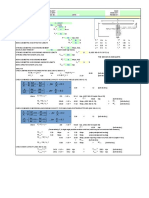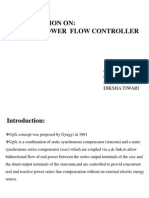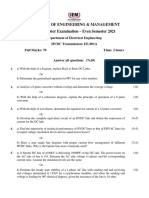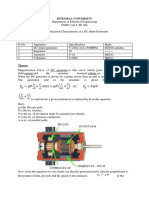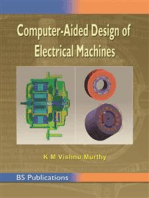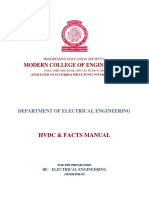Static Series Compensation (Benny Yeung)
Static Series Compensation (Benny Yeung)
Uploaded by
haseeb khanCopyright:
Available Formats
Static Series Compensation (Benny Yeung)
Static Series Compensation (Benny Yeung)
Uploaded by
haseeb khanOriginal Description:
Original Title
Copyright
Available Formats
Share this document
Did you find this document useful?
Is this content inappropriate?
Copyright:
Available Formats
Static Series Compensation (Benny Yeung)
Static Series Compensation (Benny Yeung)
Uploaded by
haseeb khanCopyright:
Available Formats
THE HONG KONG
POLYTECHNIC UNIVERSITY_________________________________________________ ___
Department of Electrical Engineering
CHAPTER 5 STATIC SERIES COMPENSATION
5.1. Introduction
Impedance of transmission line causes power flow problem. VAR compensation can increase the
transmittable power of the system. One of the solution is applying static shunt compensators such as
STATCOM and other shunt static VAR generators (SVG) to generate reactive power for compensation
to increase transmittable power and regulate voltage of the line. Another technique for compensating the
power flow of a transmission line is static series compensation.
Unexpected change of load of a transmission system may happen occasionally. Demand for power may
increase or decrease rapidly. In this case, generators of the power system may be turned on or off to
produce appropriate level of power. However, response of generators may not be fast enough to
compensate the change of load so that voltage sags or voltage surges may occur. A long distance
transmission line can be considered as including many series inductance of each line and many
capacitance between each pair of lines. Changes of power flow of the line may cause oscillation and
influence the stability of voltage.
Static series compensation technique can be used not only to increase power flow ability but also to
damp the oscillation of the voltage of the transmission line effective. It can also eliminate voltage sags
or surges as well. This chapter introduces different static series compensation techniques mainly on
VAR compensation. Other function of this technique will be discussed in further chapters. Static series
compensators belong to family of flexible AC transmission system (FACTS).
5.2. Series Capacitive Compensation
Impedance of transmission line causes reduction of voltage from the voltage of the sending end to its
receiving end. Fig. 5.1 shows an equivalent diagram of and the phasor diagram of a transmission line
with a series parasitic reactance under series capacitive compensation. The resistance of the
transmission line is assumed as zero. In practice, the parasitic reactance of the transmission line, X, is
inductive. An AC capacitor with its reactance, XC, is connected in series for compensation.
I X XC
IXC
IX
VS Load R VR VS
I(X - XC)
δ
VR
(a) Equivalent circuit (b) Phasor diagram of voltage and current
Fig. 5.1. Power transmission line with series reactance under series capacitive compensation
The voltage of the sending end of the transmission line is:
VS V R I 2 X X C
2 2 2
(5.1)
The power of the load is:
VS I 2 X X C
2 2
P (5.2)
R
The difference of the voltage of the sending end and the voltage of the load is zero if XC is equal to X.
Since the total reactance of the transmission line is reduced and the reactive power of X is compensated,
the real power transmitted to the load increases if XC is closer to X.
Power Electronics for Utility Applications Page 1
THE HONG KONG
POLYTECHNIC UNIVERSITY_________________________________________________ ___
Department of Electrical Engineering
Series capacitive compensation can also enhance the ability of I X XC
power flow in an inter-connection system. Fig. 5.2 shows a
simplified diagram of two voltage sources interconnected in a
transmission line with series capacitive compensation. If the V1 V2
phase difference of the voltage sources of the sending, V1, and
the receiving ends, V2, is α, and the voltage amplitudes of both
Fig. 5.2. A simplified diagram of
voltage sources are equal to V, the real power transmitted from
two power sources inter-connected in a
the sending end is: transmission line with an impedance
V2
P1 sin (5.3)
X XC
Equation (5.3) shows that transmittable real power increases when XC is closer to X. Disadvantages of
this compensation method are that the reactance of the compensator cannot be controlled and oscillation
may occur from the resonance of the inductance of the line and the capacitance of the compensator. If
XC is adjustable and controllable, performance of compensation will be more dynamic.
5.3. Variable Impedance Type Series Compensators
Variable impedance type series compensator is also a type of static VAR generator (SVG). They are
connected in series with the transmission system for VAR compensation and power flow regulation by
varying their reactance. The most common types of variable impedance types SVG are:
- Thyristor Switched Series Capacitor (TSSC)
Similar structure with thyristor switched capacitor (TSC)
- Gate turn-off Thyristor Controlled Series Capacitor (GCSC)
Similar structure with TSSC but using GTO instead of SCR
- Thyristor Controlled Series Capacitor (TCSC)
Similar structure with fixed capacitor thyristor controlled Reactor (FC-TCR)
5.3.1. Thyristor Switched Series Capacitors (TSSC)
Fig. 5.3 and Fig. 5.4 show a circuit diagram and its idealised vC
waveform of a single thyristor switched series capacitor I C
(TSSC), respectively. This circuit consists of an AC
capacitor, C, connected in series with the transmission line T1
and a bidirectional switch formed by two back-to-back
thyristors, T1 and T2, connected across the capacitor. When T2
the bidirectional switch is on, C is bypassed. Connecting Fig. 5.3. Circuit diagram of a TSSC
more than one TSSC in series, level of compensation can be
varied by controlling the switch of each TSSC as shown in
Fig. 5.5. vC
I
SW ON SW OFF SW ON
Fig.5.4. Idealised waveforms of a TSSC
TSSC1 TSSC2 TSSCn
Fig.5.5. A chain of TSSCs in series
Power Electronics for Utility Applications Page 2
THE HONG KONG
POLYTECHNIC UNIVERSITY_________________________________________________ ___
Department of Electrical Engineering
For a standalone TSSC, referring to Fig. 5.4 and Fig. 5.5, T1 Imax
and T2 are injecting gate current for keeping on when not I
processing compensation. When the gate current is
removed from the thyristors when the line current, I, i.e., the
bidirectional switch current, is negative, the bidirectional
switched will be switched off by natural commutation when
I reaches zero. In this moment, compensation is processing
by C. The positive half of I charges C from zero to its VCmax
maximum voltage and the negative half of I discharges C
from its peak to zero. Compensation can be off by VC
switching on the thyristors. Avoiding high discharging Fig.5.7. Operating V-I characteristic
current from C, the switch has to be on only when the of 4 series TSSC
capacitor voltage, capacitor voltage, vC, is zero. Let ω be
the angular frequency of the line voltage, the voltage of C is derived by:
dvC t
C I Iˆ sin t (5.5)
dt
where Iˆ is the amplitude of I. The equation of VC is:
Iˆ
vC t 1 cos t (5.6)
C
The peak value of VC is:
2 Iˆ
VˆC at t (5.7)
C
The impedance of the TSSC when the switch is off is:
1
XC (5.8)
C
V-I characteristic of a chain of TSSC is shown in Fig. 5.7. It shows that vC depends on the line current
of the transmission line.
5.3.2. Gate Turn-off Thyristor Controlled Series Capacitors (GCSC)
Standalone TSSC cannot adjust the compensating reactance of the compensating capacitor so that level
of compensation cannot be regulated. Fig. 5.8 and Fig. 5.9 show the circuit diagram and idealised
waveforms of a gate-turn-off thyristor controlled series capacitors (GCSC). The structure of the circuit
of a GCSC is very similar to TSSC but the thyristors (SCR) are replaced by gate-turn-off thyristors
(GTO) to form a bidirectional switch. The GTO bidirectional switch can be switched on and off upon
command so that the fundamental capacitor voltage, vC1, and the impedance, XC, of the GCSC can be
varied by the turn-off delay angle, γ. γ is within 0 and π /2.
In Fig. 5.8, the bidirectional switch is switched off with different turn-off delay angle, γ. γ is defined as
0 at the crest of the line current, I. The voltage of the capacitor is expressed as:
t t
v C t i t dt
1 1
C C Iˆ cos tdt (5.9)
Iˆ
vC t sin t sin (5.10)
C
where Iˆ is the amplitude of I.
Power Electronics for Utility Applications Page 3
THE HONG KONG
POLYTECHNIC UNIVERSITY_________________________________________________ ___
Department of Electrical Engineering
The amplitude of fundamental capacitor voltage, called effective vC
capacitor voltage, and the effective impedance of the GCSC can be I C
expressed as a function of γ and:
T1
Iˆ
VC1
2 1
1 sin 2 (5.11)
C T2
1 Fig. 5.8. Circuit diagram
X C1
2 1
1 sin 2 (5.12) of a GCSC
C
GCSC can be operated with controlling VC1 for voltage compensation γ = 0º
to regulate the voltage of the receiving end, and controlling XC1 for vC=vC1
I
impedance compensation for enhancing power flow ability of the
transmission line. Fig. 5.1 shows a V-I characteristic of a GCSC. It
shows that vC depends on I until vC is equal to VCmax. vC has to be
kept not higher than VCmax by decreasing the turn-off delay angle, γ, γ = 30º
while I is over Ilow and is increasing . vC
vC1 I
Ilow Imax
I
γ = 60º
vC I
vC1
VCmax
Fig. 5.9. Idealised waveform of
VC a GCSC with different turn-off
Fig.5.10. Operating V-I characteristic of a GCSC delay angles
5.3.3. Thyristor Controlled Series Capacitors (TCSC)
Fig. 5.11 shows a circuit diagram of a thyristor controlled series VC
capacitor (TCSC) consisting of a series compensating capacitor, C, I IC C
connected in parallel with a thyristor controlled reactor (TCR). The IL T1
function of the TCR in a TCSC is for cancelling partially
compensation from C. A TCSC provides a continuously variable L
capacitive reactance (capacitive mode) or inductive reactance T2
(inductive mode) by controlling the turn-on delay angle of the Fig. 5.11. Circuit diagram
of a TCSC
bidirectional switch, α, of the internal TCR. However, in most
practical application, a TCSC is for providing variable capacitive
reactance so that the maximum effective reactance of the TCR, XL1, is lower than reactance of the
capacitor, XC. In other words, the reactance of the inductor, XL is lower than XC. The effective reactance
of the TCR in the function of the turn-on delay angle, α, is:
X L1 X L for 0 (5.13)
2 sin 2 2
The effective reactance of the TCSC is:
X C X L1
X TCSC X C // X L1 (5.14)
X L1 X C
Power Electronics for Utility Applications Page 4
THE HONG KONG
POLYTECHNIC UNIVERSITY_________________________________________________ ___
Department of Electrical Engineering
V-I characteristic of a TCSC is shown in Fig. 5.12. The VL
fundamental compensating voltage of the TCSC varied VLmax α = 0º
by changing the delay angle, α. The compensating
voltage tends to be more capacitive while α decreases.
Capacitive Inductive
Increasing α
5.4. Variable Source Type Series Compensators Imax
I
A variable source type series compensator (also called
variable source type series static VAR generator) consists
of a switched mode converter. Similar to the shunt type
variable source type SVG, this type of series VCmax α = 90º
compensators acts as a series voltage source providing VC
instantaneous VAR control. Response of this type of
Fig. 5.12. Operating V-I characteristic of a
series compensators is faster than the variable impedance TCSC
type counterparts because the switched mode converter is
operated with fast switching devices such as IGCT and IGBT. Voltage of the variable impedance series
compensators is proportional to the amplitude of the line current while variable source type series
compensators full range of compensating voltage with any amplitude of line current. Similar to variable
impedance types compensators, variable source type series compensator can be used for voltage stability
of the receiving end and for power flow control of the transmission line. One of the most common
variable source type series compensator is static synchronous series compensator (SSSC).
5.4.1. Variable Source Type Series Compensation for Voltage Stability
Fig. 5.13 shows an equivalent circuit and a phasor diagram of a transmission line with variable source
type series compensator for voltage stability. The voltage source, Vq, is the series compensator shown in
the figure. The modes of operations of the compensator are in the followings.
- Standby Mode
Not operated temporarily.
- Capacitive Mode
Vq lags the line current by 90°, operating as a variable capacitor
- Inductive Mode
Vq leads the line current by 90°, operating as a variable inductor
Vq VX
I Vq
IX
X
VS
VS Load R VR IX - Vq
δ
VR
(a) Equivalent circuit (b) Phasor diagram of voltage and current
Fig. 5.13. Power transmission line with series voltage source for compensation for voltage stability
Let δ be the phase angle of the voltage of the source, VS, and α be the power angle, i.e., the phase angle
of the compensating voltage, the voltage across the load is:
VR 0 VS Vq IX 90 (5.15)
For VR = VS,
Vq IX 90 (5.16)
Power Electronics for Utility Applications Page 5
THE HONG KONG
POLYTECHNIC UNIVERSITY_________________________________________________ ___
Department of Electrical Engineering
5.4.2. Variable Source Type Series Compensation for Power Flow Control
Fig. 5.14 shows a variable source type series Vq VX
compensator connected in series in a power I
transmission line for power flow control. There are X
two interconnected voltage sources in the
transmission line on the sending end with the voltage VS VR
of VS and on the receiving end with the voltage of
VR. It is assumed that the resistance of the
transmission line is zero and the compensator is Fig. 5.14. A simplified diagram of
two power sources inter-connected in a transmission
lossless. The reactance of the transmission line is X.
line with series compensation
If the amplitude of VS and VR are the both equal to
V, and VS is leading VR by δ, transmittable power of
the transmission line from the sending end to the
receiving end without compensation is give as:
V2
P sin (5.17)
X
VX Vq VX
VX
Vq
33%
VS 0% VR VS VR VS -100% VR
I I I
δ δ δ
(a) Standby Mode (b) Capacitive Mode (c) Inductive Mode
Fig. 5.15. Phasor diagrams of a variable source type series compensator for power flow control
With series compensation, the voltage between the sending end and receiving end is equal to VX – Vq
where Vq is the output voltage of the compensator and VX is the voltage across the equivalent impedance
of the transmission line. Phasor diagrams of a transmission line with variable source type series
compensation for power flow control is shown in Fig. 5.15. In normal operation, Vq is 90° lagging to the
line current for capacitive mode and 90° to the line current for inductive mode. According to the phasor
diagrams, the phase different between the line current, I, and VS is δ /2. From the phasor diagram,
amplitude of VX can be increased or decreased when changing Vq so that the line current, which flows
through X, changes. If VX increases, the line current increases. Hence, this technique can control power
flow of the interconnect transmission system. The transmittable power from the sending end to the
receiving end is:
V2 VVq
P sin cos (5.18)
X X 2
It is noted that Vq is negative in capacitive mode, which is lagging to line current by 90°. Variable
source type compensators can increases transmittable power in the operating range of the power angle, δ,
from 0° to 90°. Similar to the variable impedance type counterparts, this type of compensator does not
absorb or generate real power. Fig. 5.16 shows a typical plot of real power flow between two sources
with variable impedance source series compensation.
Power Electronics for Utility Applications Page 6
THE HONG KONG
POLYTECHNIC UNIVERSITY_________________________________________________ ___
Department of Electrical Engineering
1.5
Vq = -0.707
Vq = -0.353
(normalised)
Power
Vq = 0
1
0.5
0 π/6 2π/6 π/2 4π/6 5π/6 π
Power Angle (δ)
Fig. 5.16. A typical plot of real power flow between two sources with variable source type series compensation
5.4.3. Static Series Synchronous Compensator (SSSC)
Vq
Static series synchronous compensator (SSSC) is a kind of I
variable impedance type series compensator. Fig. 5.16 shows its
circuit diagram. An SSSC consists of a DC/AC switched mode
converter which is a voltage source inverter (VSI) converting
voltage from DC to AC and generating compensating voltage, a DC/AC
DC capacitor for supplying DC link voltage to the VSI, and an Switching
injection transformer for stepping up the output voltage of the Converter
VSI to the line. The transformer is connected in series with the
transmission line. It also provides electrical isolation Cu
environment to the VSI. The VSI is operated with fast switching
devices at high switching frequency for fast response. For high Vdc
performance of compensation, closed-loop control is applied to SSSC
regulate the compensating voltage and the phase angle. Fig. 5.16. Circuit diagram of a SSSC
5.4.3.1. Characteristics of SSSC
SSSC generates reactive power by producing VL
compensating voltage. Fig. 5.17 shows the V-I
VLmax
characteristic of a SSSC. A SSSC can produce maximum
inductive and capacitive compensating voltage with any
Capacitive Inductive
level of line current. Level of compensation or amount of
power transmitted in the transmission line can be varied. Imax
Balancing of real power flow of transmission lines in I
multiline system can be achieved.
SSSC has the ability to provide compensation for the line
resistance by injecting real power. Real power can be
produced from an external DC power supply for supplying VCmax
DC link voltage by connecting in parallel with the DC link VC
capacitor, Cu. . If Vq is not 90° out of phase with line Fig. 5.17. Operating V-I characteristic
current, real power is generated. of a SSSC
Power Electronics for Utility Applications Page 7
THE HONG KONG
POLYTECHNIC UNIVERSITY_________________________________________________ ___
Department of Electrical Engineering
SSSC has the ability of power oscillation damping. The effectiveness of power oscillation damping can
be increased by modulating the series reactive compensation and by concurrently injecting an alternating
virtual real impedance (acting as a resistor) when absorbing real power.
Comparing to variable impedance types series compensators, SSSC has higher power loss because of the
use of switching devices and high switching frequency in the VSI.
5.4.3.2. Basic Control Scheme of SSSC
SSSC is always operated with closed-loop control for varying real and reactive power for compensation
and for synchronising with the fundamental frequency of the line voltage. Voltage of the DC link
voltage, Vdc, is also under controlled by the closed-loop control system. Fig. 5.18 shows the block
diagram of a closed-loop control system for a SSSC.
Vq Vq
I
Real and i
reactive voltage
Phase- Phase-
computer Polarity
shifter locked
detector
VqQ VqP ± π /2 loop
θ
|VqQRef | α θ+α
Magnitude Gate DC/AC
Error
VqR and angle Pattern Switching
amplifier Converter
computer logic
Vq
VqRRef VpRef Cu
ABS
Error Vdc
Vdc
amplifier
VqQRef VdcRef
Fig. 5.18. Block diagram of a basic control scheme of a SSSC
The reactive power output is controlled by the output voltage of the VSI in the form of PWM and angle.
The feedback signals are the line current, i, the output voltage of the SSSC, Vq, and the DC link voltage,
Vdc. Control input signals include the reactive voltage reference, VqQRef, the real voltage reference, VqRRef,
and the DC link voltage reference, VdcRef. Similar to the control scheme of a STATCOM, the output
voltage of a SSSC is decomposed into real and reactive components. These components are compared
to the magnitude of VqQRef and the real voltage reference VqRRef + VpRef. The real and reactive voltage
error signal is converted into the magnitude and angle of the desired output voltage and output angle.
The polarity of VqQRef is also detected to determinate capacitive or inductive modes of operation of the
SSSC. Appropriate gate signals are generated for the switching devices of the VSI.
Power Electronics for Utility Applications Page 8
THE HONG KONG
POLYTECHNIC UNIVERSITY_________________________________________________ ___
Department of Electrical Engineering
P I Vq cos
V 90 Vq V 90
I
X
Vq
I
V
sin j cos j sin 90 cos j sin
X X
Vq
I
V
sin j cos j cos 0 cos j sin
X X
2
Vq
cos j sin
V
I sin j 2 sin
X 2 X
V cos V cos V V sin Vq sin
2 2
I
q
X
2V (1 sin ) 2VVq sin Vq
2 2
I
X
Vq 2V 2 (1 sin ) 2VVq sin Vq
2
P cos
X
V cos V q cos V V sin Vq sin
2 2
V 2 cos2 2VVq cos cos Vq cos2 V 2 2V 2 sin V 2 sin 2 2VVq sin 2VVq sin sin Vq sin 2
2 2
2V 2 (1 sin ) Vq 2VVq (cos cos sin sin ) 2VVq sin
2
2V 2 (1 sin ) 2VVq sin Vq
2
2V 2 2V 2 sin Vq 2V 2VVq cos
2
V 2
2V 2 sin V 2 sin 2 2VVq sin 2VVq sin sin Vq sin 2
2
Power Electronics for Utility Applications Page 9
You might also like
- Structures Plastic Collapse of A Portal Frame0% (1)Structures Plastic Collapse of A Portal Frame2 pages
- Operation of A DSTATCOM in Voltage Control ModeNo ratings yetOperation of A DSTATCOM in Voltage Control Mode7 pages
- Experiment 4 - EE 308 Flyback ConverterNo ratings yetExperiment 4 - EE 308 Flyback Converter19 pages
- ECE 8830 - Electric Drives: Topic 16: Control of SPM Synchronous Motor DrivesNo ratings yetECE 8830 - Electric Drives: Topic 16: Control of SPM Synchronous Motor Drives59 pages
- Power Systems Protection Course: Al-Balqa Applied UniversityNo ratings yetPower Systems Protection Course: Al-Balqa Applied University48 pages
- Institute of Engineering & Management Mid Semester Examination - Even Semester 2021No ratings yetInstitute of Engineering & Management Mid Semester Examination - Even Semester 20212 pages
- Virtual Model For Automatic Synchronization of Alternator With Infinite Busbar Using MATLAB SIMULINKNo ratings yetVirtual Model For Automatic Synchronization of Alternator With Infinite Busbar Using MATLAB SIMULINK6 pages
- EE450: High Voltage Engineering: Lecture 22, 23No ratings yetEE450: High Voltage Engineering: Lecture 22, 2351 pages
- Module-4 Reactive Power Compensation and Voltage ControlNo ratings yetModule-4 Reactive Power Compensation and Voltage Control24 pages
- L6-Amplitude and Phase Comparator and Duality - S6No ratings yetL6-Amplitude and Phase Comparator and Duality - S616 pages
- Clarke and Park Transformation: Chapter at A GlanceNo ratings yetClarke and Park Transformation: Chapter at A Glance9 pages
- Transient Stability Improvement of Power System Using Upfc100% (1)Transient Stability Improvement of Power System Using Upfc18 pages
- Loadcell Troubleshooting & Transcell TI-1500VC Controller Callibration StepsNo ratings yetLoadcell Troubleshooting & Transcell TI-1500VC Controller Callibration Steps3 pages
- Control of HVDC Transmission System Based On MMCNo ratings yetControl of HVDC Transmission System Based On MMC22 pages
- Concept of Subtransient, Transient & Steady State: FacebookwhatsapptwitterlinkedinNo ratings yetConcept of Subtransient, Transient & Steady State: Facebookwhatsapptwitterlinkedin4 pages
- P.F. & P.F Improvement of Using CapacitorNo ratings yetP.F. & P.F Improvement of Using Capacitor3 pages
- Electrical Engineering Diploma Based 73 Important MCQNo ratings yetElectrical Engineering Diploma Based 73 Important MCQ12 pages
- Experiment No. 1 Frequency Response of A Common-Emitter (CE) AmplifierNo ratings yetExperiment No. 1 Frequency Response of A Common-Emitter (CE) Amplifier6 pages
- Singly-Excited and Doubly Excited SystemsNo ratings yetSingly-Excited and Doubly Excited Systems4 pages
- 4.design of Subtransmission Line and Distribution SubstationsNo ratings yet4.design of Subtransmission Line and Distribution Substations40 pages
- Power System Protection (EE 703-N) : Chapter:1 INTRODUCTION100% (1)Power System Protection (EE 703-N) : Chapter:1 INTRODUCTION41 pages
- Sharif College of Engineering & TechnologyNo ratings yetSharif College of Engineering & Technology1 page
- First Floor Plan: Bath 8'-0"x6'-0" Bath 6'-6"x8'-0" Bed 15'-10 "x15'-0"No ratings yetFirst Floor Plan: Bath 8'-0"x6'-0" Bath 6'-6"x8'-0" Bed 15'-10 "x15'-0"1 page
- Ground Floor Plan: Gspublisherengine 0.36.100.100No ratings yetGround Floor Plan: Gspublisherengine 0.36.100.1001 page
- Physical Science Definitions Physics PDFNo ratings yetPhysical Science Definitions Physics PDF4 pages
- Impedance-Based Winkler Spring Method For Soil-Pile Group Interaction AnalysisNo ratings yetImpedance-Based Winkler Spring Method For Soil-Pile Group Interaction Analysis0 pages
- Qus 103 Basic Engineering Science PracticalsNo ratings yetQus 103 Basic Engineering Science Practicals10 pages
- Electrode Arrays: 4.6 DC Resistivity and IP Field Systems, Data Processing and InterpretationNo ratings yetElectrode Arrays: 4.6 DC Resistivity and IP Field Systems, Data Processing and Interpretation8 pages
- Ec-10 Emergency Switchboard (Incl Test Report)100% (1)Ec-10 Emergency Switchboard (Incl Test Report)72 pages
- Andrade-Sánchez 2023 Eur. J. Phys. 44 065401No ratings yetAndrade-Sánchez 2023 Eur. J. Phys. 44 06540127 pages
- Experimental Study On Failure Modes and Retrofitting Method of Latticed Transmission TowerNo ratings yetExperimental Study On Failure Modes and Retrofitting Method of Latticed Transmission Tower14 pages
- Heat Transfer Across Banks of Tubes (Week 8)No ratings yetHeat Transfer Across Banks of Tubes (Week 8)15 pages
- Sluis Et - Al. (2014) - Modelling of A Pile Row in A 2D Plane Strain FE-AnalysisNo ratings yetSluis Et - Al. (2014) - Modelling of A Pile Row in A 2D Plane Strain FE-Analysis7 pages
- ECE 8830 - Electric Drives: Topic 16: Control of SPM Synchronous Motor DrivesECE 8830 - Electric Drives: Topic 16: Control of SPM Synchronous Motor Drives
- Power Systems Protection Course: Al-Balqa Applied UniversityPower Systems Protection Course: Al-Balqa Applied University
- Institute of Engineering & Management Mid Semester Examination - Even Semester 2021Institute of Engineering & Management Mid Semester Examination - Even Semester 2021
- Virtual Model For Automatic Synchronization of Alternator With Infinite Busbar Using MATLAB SIMULINKVirtual Model For Automatic Synchronization of Alternator With Infinite Busbar Using MATLAB SIMULINK
- Module-4 Reactive Power Compensation and Voltage ControlModule-4 Reactive Power Compensation and Voltage Control
- L6-Amplitude and Phase Comparator and Duality - S6L6-Amplitude and Phase Comparator and Duality - S6
- Clarke and Park Transformation: Chapter at A GlanceClarke and Park Transformation: Chapter at A Glance
- Transient Stability Improvement of Power System Using UpfcTransient Stability Improvement of Power System Using Upfc
- Loadcell Troubleshooting & Transcell TI-1500VC Controller Callibration StepsLoadcell Troubleshooting & Transcell TI-1500VC Controller Callibration Steps
- Concept of Subtransient, Transient & Steady State: FacebookwhatsapptwitterlinkedinConcept of Subtransient, Transient & Steady State: Facebookwhatsapptwitterlinkedin
- Electrical Engineering Diploma Based 73 Important MCQElectrical Engineering Diploma Based 73 Important MCQ
- Experiment No. 1 Frequency Response of A Common-Emitter (CE) AmplifierExperiment No. 1 Frequency Response of A Common-Emitter (CE) Amplifier
- 4.design of Subtransmission Line and Distribution Substations4.design of Subtransmission Line and Distribution Substations
- Power System Protection (EE 703-N) : Chapter:1 INTRODUCTIONPower System Protection (EE 703-N) : Chapter:1 INTRODUCTION
- Power System Wide-area Stability Analysis and ControlFrom EverandPower System Wide-area Stability Analysis and Control
- Computer Aided Design of Electrical MachinesFrom EverandComputer Aided Design of Electrical Machines
- First Floor Plan: Bath 8'-0"x6'-0" Bath 6'-6"x8'-0" Bed 15'-10 "x15'-0"First Floor Plan: Bath 8'-0"x6'-0" Bath 6'-6"x8'-0" Bed 15'-10 "x15'-0"
- Impedance-Based Winkler Spring Method For Soil-Pile Group Interaction AnalysisImpedance-Based Winkler Spring Method For Soil-Pile Group Interaction Analysis
- Electrode Arrays: 4.6 DC Resistivity and IP Field Systems, Data Processing and InterpretationElectrode Arrays: 4.6 DC Resistivity and IP Field Systems, Data Processing and Interpretation
- Experimental Study On Failure Modes and Retrofitting Method of Latticed Transmission TowerExperimental Study On Failure Modes and Retrofitting Method of Latticed Transmission Tower
- Sluis Et - Al. (2014) - Modelling of A Pile Row in A 2D Plane Strain FE-AnalysisSluis Et - Al. (2014) - Modelling of A Pile Row in A 2D Plane Strain FE-Analysis




